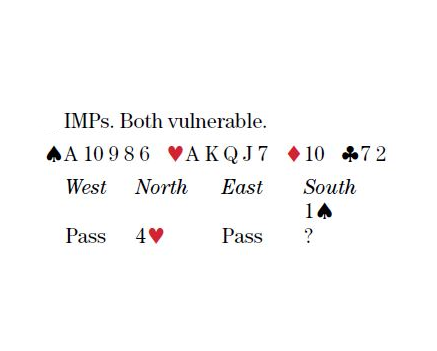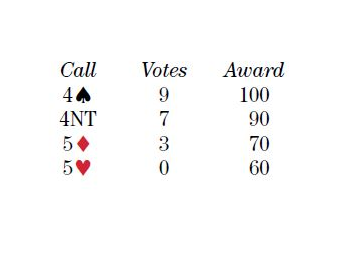
What’s your call?
| 4♠ | 4NT | |||
| 5♣ | 5♦ | 5♥ | 5♠ | 5NT |
| 6♣ | 6♦ | 6♥ | 6♠ | 6NT |
| 7♣ | 7♦ | 7♥ | 7♠ | 7NT |
| Dbl | Pass |
I hate it when partner does that!
Nine panelists hear partner’s shortness in their strongest suit and give up.
“I wouldn’t expect a one-under splinter to have a very good hand rich in controls,” Robinson asserts. Partner could have:
♠K Q x x ♥x ♦K Q x x ♣Q J x x
or
♠K Q x x ♥x ♦K Q J x ♣K x x x,
and we would not be safe at the five level. With a better hand, partner should bid 2NT.”
Hampson agrees. “I have lots of tricks but I need several specific cards to make slam strong: ♠K and the ace of the correct minor to start. Lastly, there is no five-level safety.”
Sanborn believes that splinters should be limited to a maximum of about 13 HCP. “Unless we are facing three aces or two aces and the right K–Q, slam is not a bargain. In my opinion, good support hands begin with 2NT.”
Cohen backs off. “Partner needs too many right cards for slam to be good. I fear being off the first two club tricks if I get scientific and help them out on lead.”
Falk, too: “This question is about partner’s style. If North is ‘old school,’ he must have at least an ace in one minor and the king in the other. If he also has ♠K Q, slam might be a
finesse or better. But few Norths are so restrictive these days. Even:
♠K x x x ♥x ♦A J x x ♣K x x,
a near perfecto, is only a 25% slam. If I could guarantee that the opponents would lead a major suit, I would just leap to slam, expecting to ditch enough minor-suit losers on my hearts to score it up. But opponents don’t generally do what I want, so I’ll take my plus score. Basically, I have huge wastage opposite heart shortness, so I rein myself in accordingly.”
“There are many hands opposite which we will not be safe at the five level,” says Stack. Basically this hand is just two aces. But if partner can bid again, we have a hand that will cooperate.”
There is, however, a hefty contingent who stare down the heart splinter and bid Blackwood anyway.
“Partner shouldn’t splinter in one under the trump suit without a good hand because it leaves no room to investigate slam below game,” says Weinstein. “Asking for key cards is the easiest way to get to a grand when it’s cold. Bidding 5♦ doesn’t help us find a grand, and it pinpoints a club lead.”
“4NT,” key cards Rigal. “Hope to pitch fast or slow club losers if they don’t find the right lead. These days, many, including me, play 1♠–3NT as a mini-splinter and 4♥ as 12–14 or so with a splinter. I’d be happier to bid on with that agreement, of course.”
Boehm says he’s willing to chance two fast club losers in order to reach a possible grand. “Partner could hold king-fifth in spades and ace-king-ace in the minors, or the like.”
“I like to play that key card shows controls in the other suits,” Meyers says, “regardless, I still bid key card.”
“4NT,” says Lawrence. “I will bid five, six or seven according to what partner shows. The more important issue is that this hand shows how a splinter bid can get in your way. Partner should not make a 4♥ splinter raise with more than a minimum hand
— 4♥ takes away so much bidding room. If he has a very good hand, he has to be prepared to bid again.”
The Coopers highlight the lack of a club control by bidding 5♦. “If partner has decent spades and the ♣A, we should be able to pitch his club losers on our hearts.”
“5♦,” cuebid Isfeld and Henneberger. “I feel I need to make a move, and key-carding with two low cards in a side suit is ill advised.”

